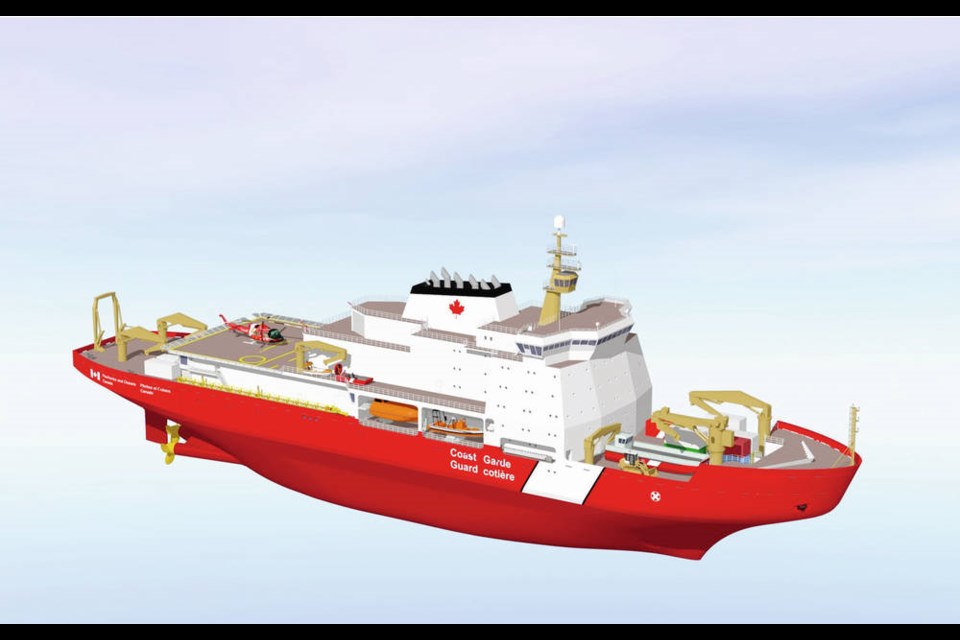Victoria Shipyards and Island-based marine suppliers are likely to reap economic benefits after Seaspan Shipyards was awarded a contract for one of Canada’s new heavy icebreakers.
“We have a pretty rich and skilled supply chain community on the Island and in Victoria — all boats rise when you have a massive program like the polar icebreaker,” said Amy MacLeod, vice-president of corporate affairs for Vancouver-based Seaspan. “The opportunities are not just for Seaspan, they are for the marine industry.”
MacLeod said the massive project will require the time, talent, products and services of hundreds of companies over several years, and is expected to provide continuous employment for about 1,400 people.
The bulk of the work will be done at Seaspan’s North Vancouver Shipyard, which was purpose-built for the polar icebreaker project.
Liberal cabinet ministers announced Thursday the government had doubled the number of heavy icebreakers it will build over the next decade, with Seaspan and Quebec-based Chantier Davie being given one each.
The surprise announcement followed nearly two years of questions — and intense lobbying from the shipyards — over Ottawa’s plans for CCGS John G. Diefenbaker.
First announced by Stephen Harper’s Conservative government in 2008 and awarded to Seaspan in October 2011, the Diefenbaker was one of seven ships to be built by the Vancouver shipyard through Ottawa’s multibillion-dollar shipbuilding plan.
The Diefenbaker was arguably the crown jewel of the package. Originally budgeted at $721 million, the icebreaker was supposed to be delivered by 2017 and replace the Coast Guard’s flagship, CCGS Louis S. St-Laurent.
But scheduling conflicts, technical problems and other issues scuttled the timeline and budget — which was increased to $1.3 billion in 2013 — before the Trudeau government quietly lifted the ship from Seaspan’s order book in August 2019.
Seaspan and Davie subsequently engaged in fierce lobbying to secure the work. In the end, the Liberals gave each a new icebreaker to build.
Fisheries Minister Bernadette Jordan defended the decision to split the work between the two shipyards as a prudent step given the pressing need to get the two vessels in the water as soon as possible.
The St-Laurent is scheduled to be retired in 2030 while the Coast Guard’s other heavy icebreaker, CCGS Terry Fox, is set to follow in 2032.
“To expedite this work, both polar icebreakers will be built at the same time in two different Canadian shipyards,” Jordan said.
The decision will almost certainly come with a hefty price tag. The federal government has previously emphasized the savings that come with one shipyard working on multiple models of the same vessel, with the first vessel in a class costing much more and taking much longer than those that follow.
Liberal ministers refused on several occasions Thursday to provide any cost estimate or budget for the two icebreakers, saying such information would be provided at an appropriate time.
Senior civil servants, speaking at a briefing provided on condition of anonymity, did acknowledge, however, that the cost will exceed the previous $1.3-billion estimate for the Diefenbaker alone.
“As northern waterways become more accessible, some countries are trying to encroach on our sovereignty by signaling their economic interest in a region that may be rich in untapped natural resources,” Environment Minister Jonathan Wilkinson said.
“So we simply can’t put a price on the value of Canada maintaining its Arctic presence.”
Seaspan’s MacLeod said the first order of business is to get the project under contract, which will take some time, but that the North Vancouver shipyard is ready to start any time.
“We had this ship built into our production schedule and it’s still baked into it,” she said. “We are good to go.”
The Association of British Columbia Marine Industries said the news was a positive development for the industry.
“The construction of this ship will generate approximately 300 jobs at the shipyard and support thousands of jobs across a supply chain that already exceeds 650 companies in Canada,” executive director Alex Reuben said in a statement. “This is a further positive development in a continually growing industrial marine capability and capacity in British Columbia.”
The Business Council of B.C. could not quantify what effect the project might have, but said the ripple effect is bound to be massive.
“Projects of this scale have a positive impact on the economy province-wide by providing employment to the hundreds of workers who will be working on the build until completion,” spokesman Colin Wong said in a statement. “It will be positive as B.C. slowly emerges from the pandemic downturn.”
aduffy@timescolonist.com



